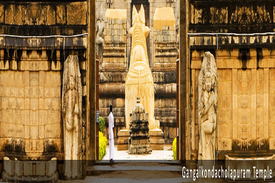Mudumalai Wildlife Sanctuary
It is located at an elevation of 1140 mts at the tri point junction of the States of Kerala, Karnataka and Tamil Nadu . First of its kind to be set up in India and forms a part of Jawaharlal Nehru National Park. It’s area is around 321 Sq.Kms. Tropical Evergreen Forest, moist Deciduous Forest, moist Teak Forest, dry Teak Forest and secondary Grassland Swamps are found here.
It is an exciting place to see animals like Tiger, Panther, Elephant, Gaur, Mouse deer, Sloth bear , Sambar, Spotted Deer, Barking Deer, Blackbuck, Malabar Giant Squirrel, Flying Squirrel, Four-horned Antelope (Chowsingha), Wild Dog, Striped Hyena, Small Indian Civet , Wild Boar, Porcupine, Slender Lories and so on. Tigers are largely elusive but leopards on the move are frequently seen. Ombetta vayal, a swampy area is mid way between upper Kargudi and Mudumalai Game Hut is a place to lookout for Elephant and Bison.
Vallanadu Deer Sanctuary
This is 35 kms from Thoothukudi on the Tirunelveli Thoothukudi highway in the Srivaikundam Tauk and located on an isolated Hilly area measuring 64 acres. This Sanctuary has been specially created for the protection of Blackbucks. Vallanadu is the southern most place in India where a natural population of Blackbuck exists. The Blackbuck population grazing in the hilly area is a common sight to watch. Apart from Black Bucks; Spotted Deer, Macaques, Jungle cat, Mongoose and wild hares are some members of the Fauna population found in this Sanctuary. The Forest Department has fenced the entire area for the protection of these blackbucks. Because of the rapid expansion activities, Poaching in sanctuaries and dwindling agriculture resources; Black Buck population is confined only to four National Parks: Guindy in Chennai, Mudumalai, Point Calimere in Napapattinam and Vallanadu in Tuticorin .
Mannar Marine National Park
This Marine park of Mannar spreads along 560 Km stretch between Rameswaram and Tuticorin. It is lying within the Bio Sphere of Mannar. Gulf of Mannar Biosphere Reserve covers an area of 10,500 Sq.KM. on the south-east coast of India. T his biosphere covers the coasts of Rameswaram, Tuticorin, Tirunelveli and Kanyakumari. It is one of the world’s richest regions from marine bio diversity perspective and it is also the first marine Biosphere Reserve in Southeast Asia. The Biosphere Reserve comprises of 21 islands with estuaries, Mudflats, Beaches, Forests of the on- shore environment, including marine components like Algae communities, Sea grasses, coral reefs, Salt marshes and Mangroves. Among the Gulf’s 3600 plant and animal species, there are globally endangered species of Sea Cow (Dugong) and six mangrove species endemic to peninsular India.
Marakairs, a local community is engaged in fishing. The Coastal Biosphere comprises of more than 125 villages and about 1,00,000 human population. The Biosphere conservation is becoming increasingly difficult because of the Dynamite fishing, Mechanised fishing boats, danger of fishing nets hauling un-targeted marine population and Coral Population, and excessive harvesting of fish.
Viralimalai Sanctuary
It is 30 kms from Tiruchirpalli and 40 kms from Pudukottai. The Viralimalai is a Bird Sanctuary, particularly a natural sanctuary of peacocks. Large number of those birds are found in this Hill zone. The Viralimalai town, Temple and Peacock Sanctuary have been declared and funded as a Heritage zone by the order of the Governor. The town is bestowed with a large number of wild peacocks, which roam around the Murugan temple. The sanctuary is one of the best places to watch peacocks. There are at least six species of peacock pheasants distributed throughout South East Asia, though the Palawan Peacock Pheasant or “Tandikan” (Polyplectron Emphanum) is by far the most spectacularly coloured of these beautiful birds.
Calimere Wild Life Sanctuary
It is around 70 kms from Nagapattinam and 11Kms from Vedaranyam. Point Calimere Wildlife Sanctuary was created in 1967 for conservation of Blackbuck, an endangered and endemic species of India. Point Calimere encompasses 17.26 sq KM of sandy coast fringed by saline swamps and thorny scrub around the backwaters. Migratory curlews, Terns, Plovers, Sandpipers and Shanks nest in the tidal mud flats from October to March. Black bucks, Spotted Deers, Jackal, Ponies and Wild hare are sighted very often.
Mukurthi Peak and Mukurthi National Park
Short 45 Kms drive from Udhagamandalam, martenspread over an area 79 km on the south eastern corner of the Nilgiris Plateau. The Silent valley is located on the western side of this range of mountain. This park is approachable through four different routes:
1] Via Avalanchi , upper Bhavani and sanctuary begins from the dam,
2] Via Anumapuram 24 kms from Ooty near Pykara and then via Porthimund Dam to the park
3] Via T.R.Bazar and through the Terrace Estate Road, and reach Mudimund to proceed to the National park and
4] Via Parsons Valley road that leads to Western Catchment II and III. Nilgiri Tahr [earlier called as ibex or Nilgiri ibex] is found in reasonably large numbers here. This peak is compared to the peaks of Himalayan ranges in terms of the presence of Flora and Fauna unique to a geographical location of Himalayas .
INDIRA GANDHI WILDLIFE SANCTUARY and NATIONAL PARK
There is a 30 Km wide gap [big break in the Western Ghat mountain range] between the Nilgiri Hills to the north and the Anamalai Hills to the South that straddles the Kerala and Tamil Nadu border and serves as a major communication route between them. Highways and Rail Transport connect Palghat with Coimbatore and Pollachi. This huge gap is called as Palghat Gap.
This was originally called as Anamalai Wild Life Sanctuary notified in the year 1974 and established in the year 1976. Later on renamed in honour of former Prime Minister Indira Gandhi’s visit during 1961 . It is located at an altitude of 1400 meters at the Top Slip. The National Park is 108 sq.kms core area of the total 958 Sq. Kms sanctuary zone. Indira Gandhi Wild Life Sanctuary was declared a Project Tiger Zone in the year 2008. Elephants, Gaur, Tiger, Panther, Sloth Bear, Pangolin, Black Headed Oriole, Green Pigeon and Civet cat can be seen in this Sanctuary. Karian and Anaikunthi Sholas, Grass Hills, Waterfalls, Groves, Teak forests, Estates, Dams and Reservoirs add beauty to Anamalai Hills and attracts visitors in large numbers. Elephant Safari and Van services are available at the Top Slip to take the tourists around the Sanctuary.
Mundanthurai Sanctuaries
There is nothing to differentiate this sanctuary from the Kalakkadu Sanctuary, except for the absence of the Elephant and the Gaur. Situated in the Thirunelveli district, this sanctuary has dry decidious to tropical wet evergreen forests and patches of reeds in an area of 567 sq. kms.
The animal wealth in this sanctuary includes the Tiger, Bonnet Macaque, Langurs, Slenders Loris, Sloth Bear, Sambhar, Chital and the Wild Dog. This sanctuary is excellent also for the various species of avifauna and varieties of reptiles and insects. Trekking trips along trekking trails can be undertaken with prior permission from the Forest (Wildlife) Department.
Mayura Thottam
It is 22 kms from Ottapidaram of Tuticorin District. Mayurm means peacock in local language and Thottam means Garden. Large Peacock farm is located here in an area of 55 acres, hence this place is named as Mayura Thottam. The Peacocks have made this farm their home and even breed here. The entire farm is full of Coconut Groves and Guava Trees. Tourism Department has accommodation with Bed and Breakfast plan for the benefit of the tourists. October and November is the best period, when tourists can visit and enjoy the grand sight of Peacock Dance throughout the farm.
Kalakadu Wild Life Sanctuary
It is the 17th Tiger Reserve in India and the only one in Tamil Nadu, was declared as a Tiger Reserve in 1988, located in an area of 900km². This includes two contiguous Sanctuaries namely Kalakad Sanctuary and Mundanthurai Sanctuary and a part of Kanyakumari Sanctuary. This sanctuary is very popular with a great variety of Flora and Fauna. Short list includes Tiger, Panther, Jackal and Wild dogs among the carnivores; King-cobra, Python and several other snakes among the reptiles population. The Kalakad Sanctuary was declared a forest preserve for the rare lion-tailed macaque, which is easily spotted here. The best season to visit this sanctuary is between March and September. Trekking is allowed here with the prior permission from the officials of Forest (Wildlife) Department. Other attraction in the vicinity is Kudirai Mozhitheri, a natural spring 12 kms from Tiruchendur.
Squirrel wild Life Sanctuary
Located at Srivilliputtur at an altitude that varies from 100 m to 200m, Spreads over a 480 km² of area. This was declared as a sanctuary in December 1989 as the Grizzled Squirrel Wildlife Sanctuary. The sanctuary shares a common border: on the South western side with Periyar Tiger Reserve, On the North Western side with the Megamalai Reserve Forest, Its southern border limit with the Sivagiri Reserved Forest of Tirunelveli Forest Division. Large part of the Grizzled Squirrel Wildlife Sanctuary lies mostly in Virdhunagar District and partly in the Western Ghats ranges lining Madurai district. It receives both southwest and northeast monsoons.
The varied climate and topographic conditions prevailing in the sanctuary present remarkable diversity both in Flora and Fauna. It is the eastern watershed boundary for the river Periyar and one of the best preserved forests south of the Palghat Gap . The tributaries of the river Vaipaar originates from the hill tracts of the Sanctuary and the average rainfall is between 200 to 2000mm. Hot tropical climate prevails in the upper elevations. The sanctuary has a wide range of habitats – Upper Montane forests and grasslands at higher elevation; Wet Evergreen at mid elevation and Semi Evergreen, Moist Deciduous, Open Deciduous, Closed Deciduous forests and scrub jungles at the foot hills. The sanctuary has one Medicinal Plant Conservation Area (MPCA) located at Thaniparai.




